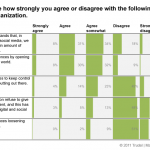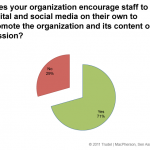How Strong is Your Social Net? 2011 Results
9. Are organizations ready to give up control?
![]() The internet and social tools work by enabling connection. As society struggles to evolve its conception of privacy to include the expectation that every person with a connection is empowered to share and interact, organizations are slowly beginning to realize that digital communication is not advertising or one-way communication.
The internet and social tools work by enabling connection. As society struggles to evolve its conception of privacy to include the expectation that every person with a connection is empowered to share and interact, organizations are slowly beginning to realize that digital communication is not advertising or one-way communication.
There’s no way around it: being online (and reaping the benefits of digital platforms to increase an organization’s visibility, reach, and interaction with its audience—in short, becoming more connected to the whole world) requires giving up a measure of control and forces a degree of transparency.
We found in our results that, while the organizations we surveyed do understand this issue (72.8%), many still struggle with it. Close to half of respondents (41.2%) agreed with the statement: “My organization struggles to keep control over the content we’re putting out there.”
The proof, ultimately, is in the experience of experimenting with transparency. A majority of organizations (70%) reported having positive experiences as a result of giving up a measure of control, while only 11.3% report having negative experiences. As organizations become more comfortable with showcasing themselves and their content, we believe that the benefits will drive further experimentation and increase confidence in becoming more transparent and directly conversant with their audiences.
![]() We asked whether organizations encourage staff to use digital and social media on their own to promote the organization’s activities. Our observation was that organizations that put clear social media policies in place and encourage their employees to be ambassadors for the organization were reporting good results.
We asked whether organizations encourage staff to use digital and social media on their own to promote the organization’s activities. Our observation was that organizations that put clear social media policies in place and encourage their employees to be ambassadors for the organization were reporting good results.
We learned that 70.6% of respondents reported being encouraged to use digital and social media on their own. The fact that this number is not 100% is a sign that some organizations are still struggling to create systems to oversee appropriate staff use of these channels or have had difficulty creating workable personal/professional boundaries. We’ve heard anecdotally that some organizations’ I.T. groups are responsible for banning access to social media sites due to mishaps like staff clicking on malware links.
Our prediction is that this number will change considerably over the course of the coming year. While there are risks (which can be mitigated with a properly communicated social media policy), staff members, volunteers, and interns are often the best ambassadors of an organization’s mission and ethos, and suppressing their ability to communicate their enthusiasm and expertise represents a lost opportunity and a poor understanding of the nature and workings of social media.
Profiles related to this topic:[posts-by-tag tags = “personal vs professional, social media policy, maintaining engagement” number = “5” excerpt = “false” thumbnail = “false” order_by = “date” order = “desc” author = “false” date = “true” content = “false”]
< Previous: Do organizations feel they’re effective? | Next: What about integration? >
Tell us about your best/worst social media experience...
…and meet digital communications pioneers.
Click on our profile template to get started.
Want to get in touch?
We’d love to hear from you. Contact us.

